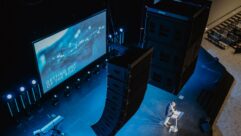Visualization Centers Put Focus on AV
Mar 7, 2007 8:40 PM,
By Linda Seid Frembes
As AV technology advances, certain market segments are pushing the boundaries of its application. In the education sector, the development of visualization centers in partnership with technology organizations and industry benefactors are putting a focus on the relationship between AV and IT.
“In the late 1990s, the oil industry created visualization centers as a way to look at large volumes of data. The first company to achieve a visualization center was Texaco, followed days later by Chevron,” explains Dr. Eric Frost, geology professor and co-director of the San Diego State University (SDSU) Visualization Center (Viz Center), who worked with several oil companies on these centers. The SDSU Viz Center and the cross-town Scripps Institution of Oceanography Visualization Center at the University of California San Diego (UCSD), are connected to Larry Smarr’s California Institute for Telecommunications and Information Technology (Calit2). The two centers were the first two to be optically linked to fully collaborate, sharing entire data visualizations and people via fiber. Optical collaboration of the people was brought together by Viz Center Co-Director Bob Welty.
“At the time, the cost to create that visualization center was $4 million, but the company was able to amortize it in less than a week. The center was a tool to make better decisions, like locating places for oil and gas wells that are worth $10 million each,” Frost says. “Within two years, there were approximately 200 of them worldwide; most of them built by Panoram Technologies or Mechdyne. Most are still standalone and not optically linked.”
Frost points out that the use of visualization centers in the education market serves several purposes. “We are trying to help people visualize large images and teach them how to interpret that level of data,” he says. “In an educational setting, these images can be used to make a window to the rest of the world or into our history. Instead of reading about the Parthenon, we’re going to visit it. For kids, immersive is much more compelling than PowerPoint. At the university level, we are pushing the envelope of looking at data sets and how to apply that in situations like telemedicine and emergency response.”
What is a visualization center?
According to Frost, a visualization center includes several display screens and projectors that allow a user to see data across all screens. Often, the view is more than 120 degrees. “It is truly immersive,” he explains. “The user sees a reality that is a composite image.”
The sophistication and cost of a visualization center runs the gamut. “Universities look at a cost of $4 million and most say no. But some universities, like University of Colorado-Boulder or Arizona State University, have invested in beautiful, high-end visualization centers,” Frost says. “Our goal at SDSU is the make this technology cost-effective to more people—especially communities. If you can make visualization centers inexpensive, then more people can access the content.”
A few years ago, a cost-effective visualization center may have run close to $500,000; however, products such as the Matrox TripleHead2Go graphics expansion module are bringing visualization capabilities to the masses. The $299 Matrox TripleHead2Go is a palm-sized box that allows one PC to drive up to three screens with a combined resolution of up to 3840×1024. A PC with two video cards and two Matrox boxes can drive six screens; three video cards can drive nine screens, and so on.
The display screens themselves can also be relatively inexpensive. Frost and Welty use Lycra cloth that stays taut and doesn’t warp with humidity or temperature changes; the Lycra can handle both front and back projection. To create a projection screen for less than $30, Frost and Welty have used 1’x 2′ pieces of wood or PVC for the frame, Lycra cloth, and some Velcro to attach the cloth to the frame. “In a pinch, you can also duct tape the cloth to the wall,” Frost says.
Frost also notes that most off-the-shelf commodity projectors are good enough for this application. He cautions that to get an accurate representation of the image, the projector lamps should be purchased and installed at the same time. “Our focus on cost savings comes from us thinking, ‘What would a fire department do?’ They would use what works and is affordable,” he says. “The content is what is compelling, not the cost of the screens or the center.”
According to Frost, a market opportunity exists for systems integrators who can understand the nuances of a visualization center, now often called a data fusion center. “Right now, no integrators have figured out how to effectively deploy stereoscopic 3-D. There is no singular place to buy a 3-D solution,” Frost says. “And another challenge is the integration of audio. We’ve found that an effective setup is to put the speaker behind the screen [like a cinema setup], but that is not the ideal solution. Linking projectors more effectively to the Matrox Triple Head2Go is also huge opportunity, as is building multi-screen visualizations and data fusion technologies, often summarized as a Common Operational Picture. Linking and sharing the world is possible.”









